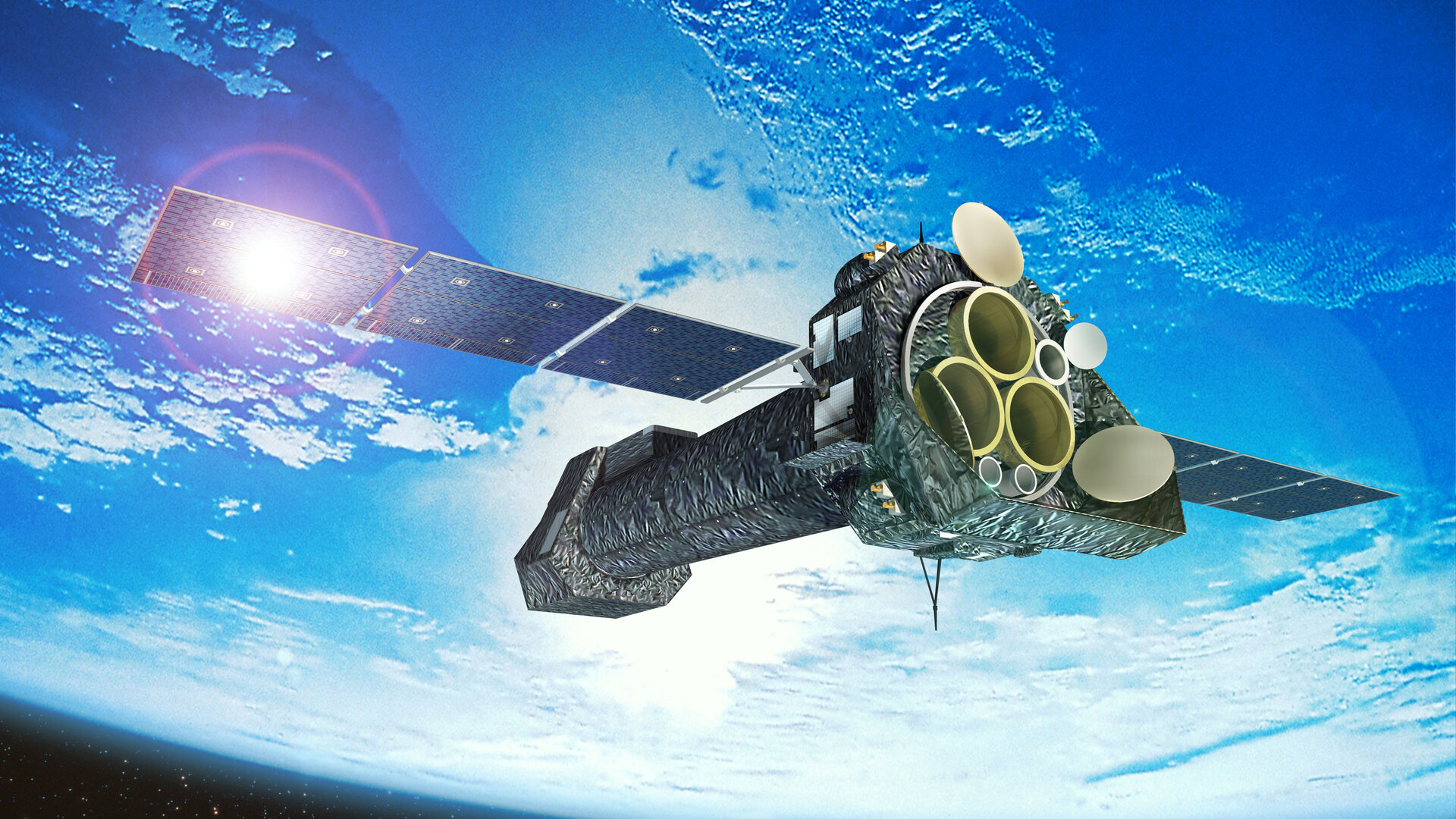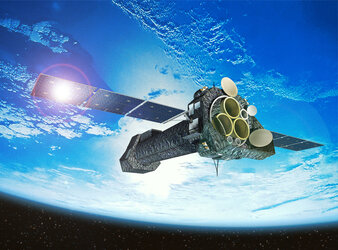XMM-Newton operations
Editor's note: This page is no longer being updated, but will be preserved as a record. Click here for the latest information on XMM-Newton.
ESA's XMM-Newton space observatory is the flagship of European X-ray astronomy. It is the most powerful X-ray telescope ever placed in orbit and is observing the 'hot' X-ray universe including objects like neutron stars, black holes and active galaxies. Over 300 scientific papers are published annually using data provided by XMM-Newton.
The satellite is detecting more X-ray sources than any previous satellite and is helping solve cosmic mysteries, from what happens in and around black holes to the formation of galaxies in our early Universe. XMM-Newton's high-tech design uses over 170 wafer-thin cylindrical mirrors spread over three telescopes.
For science colleagues and professional friends of the mission: Your invitation to 20 years of XMM-Newton
The mission
Its 48-hour orbit takes it almost a third of the way to the Moon enabling astronomers to obtain long, uninterrupted views of celestial objects. At perigee (closest approach), it passes 20 000 km to above Earth at a speed of 24 000 km/hr. XMM-Newton's highly eccentric operational orbit has been chosen so that its instruments can work outside the radiation belts surrounding the Earth.
The XMM Mission Operations Centre (MOC) is located at ESOC, Darmstadt, Germany.
| ROLE | X-ray space observatory |
| LAUNCH DATE | 10 Dec 1999 |
| LAUNCHER/LOCATION | Ariane/Kourou, French Guiana |
| LAUNCH MASS | 3800 kg |
| ORBIT | ~100 000 km apogee/~20 000 km perigee - 48 hr elliptical |
| NOMINAL MISSION | Two years - extended to 2020 |
| ++ Europe's largest-ever science satellite ++ | |
The Flight Control Team

The Flight Control Team at ESOC operates from a Dedicated Control Room co-located with ESA's Euclid and Integral missions. The Spacecraft Operations Manager, Dr Marcus Kirsch, leads a team of flight control engineers, analysts and spacecraft controllers working full-time on the mission.
The mission was originally designed for a 10-year life, however, since the satellite and instruments are operating admirably without major degradation, we hope to operate the observatory into the next 3rd decade of this century, our only limitation being the hydrazine fuel supply. Our 'baby' has been out there for a long time now and is still providing X-ray astronomers with exiting new science results daily. Having worked previously as an astrophysicist for some time on the science side of XMM, I am now putting my energy into ensuring the safe and efficient continuation of mission operations," says Marcus.
Flawless mission operations is a key element in achieving a high scientific output. The mission provides the operations team with ongoing demands; XMM-Newton, for example, has no on-board storage so all vital science data must be downloaded via a ground station as soon as it is collected.
Other ESOC teams provide specialised support to XMM-Newton in several areas, including Flight Dynamics, Ground Facilities and Software Support.
Mission operations overview

XMM was launched on Ariane Flight V 119, on board the first Ariane-5 commercial flight (504) on 10 December 1999.
The mission is now in its 'extended routine phase', and continues to address new questions for classical X-ray astronomy, from the field of black holes, to neutron stars and active galactic nuclei, as well as contributing to new hot science topics such as dark matter, dark energy and gravitational waves. Technically, the observatory currently has enough resources to operate until 2034+, providing the European X-ray community with high quality, state-of-the-art data until the launch of it successor mission, NewAthena. XMM-Newton might even fly in parallel with NewAthena for some time to generate a smooth calibration handover.
ESOC controls the mission 24/7, 365 days per year through a live ground station connection, since the spacecraft has only a limited amount of automation. However, over the years a lot of ground automation has been developed to operate it in a safe and efficient manner and to generate the highest possible science output.
In 2013, the flight control team together with industry re-programmed the on-board 'Attitude and Orbit Control System' in order to also use the back up reaction wheel. This new mode is called "4 wheel drive mode", and since 2013 has saved more than half of the fuel needed to control the spacecraft through day-to-day operations.
The on-board software has also been updated several times to improve and streamline mission operations. This has extended the remaining lifetime by a factor of two to three, currently giving the potential to operate the observatory until at least 2034.
The ground stations - Santiago de Chile, Kourou

Contact for continuous real-time interaction with the spacecraft over almost the entire orbit is provided by the ESA ground station at Kourou and via the SSC station at Santiago de Chile.
XMM-Newton's operational orbit is highly eccentric and has been chosen for two reasons. First, the XMM-Newton instruments need to work outside the radiation belts surrounding the Earth. Second, a highly eccentric orbit offers the longest possible observation periods - less interrupted by the frequent passages in the Earth's shadow that occur in a low orbit.
In addition, the orbital period of XMM-Newton is exactly two times the Earth rotation period to maintain optimal contact between XMM-Newton and the ground stations tracking the satellite. This allows XMM-Newton data to be received in real-time and for it to be fed to the Mission Control Centres.
XMM-Newton has no inboard data storage capacity, so all data is immediately downloaded to the ground in real time.
Ground segment & mission control system
The XMM-Newton ground segment uses the SCOS-2000 mission control system.
XMM-Newton has been operated, together with Gaia, Integral and now Euclid, with a joint controller team using new monitoring technologies for multi mission purposes.
The XMM-Newton SOC at ESAC manages science operations in continuous round-the-clock interaction with the MOC. The SOC is responsible for all science aspects of the mission, including relations with the science community, science observation planning, observation monitoring, quick-look analysis, instrument calibration, archiving, pipeline processing of all XMM science data and distribution.
The platform and payload
XMM-Newton carries three very advanced X-ray telescopes. They each contain 58 high-precision concentric mirrors, delicately nested to offer the largest collecting area possible to catch the elusive X-rays. These Mirror Modules allow XMM-Newton to detect millions of sources, far more than any previous X-ray mission.
The telescopes work in conjunction with cameras, a spectrometer and an optical/ultraviolet monitor.

European Photon Imaging Cameras (EPIC)
The main mirror modules sends the image beam along the telescope tube to five cameras at the extremity of the spacecraft. At the prime focus of each of the telescopes, behind six-position filters, are three European Photon Imaging Cameras (EPIC). With silicon chips that can register extremely weak X-ray radiation, these advanced charge-coupled device (CCD) cameras are capable of detecting rapid variations in intensity, down to a thousandth of a second and less.
Reflection Grating Spectrometer (RGS)
For a complementary analysis of the spectrum, a grating structure on two mirror modules reflects about half of the incoming rays to a secondary focus, with its own CCD camera. This Reflection Grating Spectrometer (RGS) "fans out" the various wavelengths, thus indicating, in more detail than EPIC, the exact condition of individual elements, such as oxygen and iron.
Optical/UV Monitor (OM)
The third instrument aboard XMM-Newton is a conventional but very sensitive Optical/UV Monitor (OM), which can observe simultaneously the same regions as the X-ray telescopes, but in the ultraviolet and visible wavelengths. This gives astronomers complementary data about the X-ray sources. In orbit, this 30-cm telescope is as sensitive as a 4-metre instrument on the Earth's surface.
For more on XMM-Newton's instruments, follow the links above at right.






